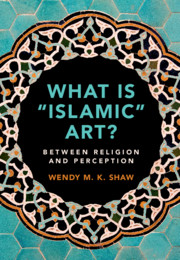Book contents
- What is “Islamic” Art?
- What is “Islamic” Art?
- Copyright page
- Epigraph
- Contents
- Figures
- Color Plates
- Preface
- Note on Transcultural Communication
- Introduction From Islamic Art to Perceptual Culture
- 1 The Islamic Image
- Chapter 2 Seeing with the Ear
- Chapter 3 The Insufficient Image
- Chapter 4 Seeing with the Heart
- Chapter 5 Seeing through the Mirror
- Chapter 6 Deceiving Deception
- Chapter 7 The Transcendent Image
- Chapter 8 The Transgressive Image
- Chapter 9 Mimetic Geometries
- Chapter 10 Perspectives on Perspective
- Conclusion Out of Perspective
- References
- Index
- Plate Section (PDF Only)
Introduction - From Islamic Art to Perceptual Culture
Published online by Cambridge University Press: 27 September 2019
- What is “Islamic” Art?
- What is “Islamic” Art?
- Copyright page
- Epigraph
- Contents
- Figures
- Color Plates
- Preface
- Note on Transcultural Communication
- Introduction From Islamic Art to Perceptual Culture
- 1 The Islamic Image
- Chapter 2 Seeing with the Ear
- Chapter 3 The Insufficient Image
- Chapter 4 Seeing with the Heart
- Chapter 5 Seeing through the Mirror
- Chapter 6 Deceiving Deception
- Chapter 7 The Transcendent Image
- Chapter 8 The Transgressive Image
- Chapter 9 Mimetic Geometries
- Chapter 10 Perspectives on Perspective
- Conclusion Out of Perspective
- References
- Index
- Plate Section (PDF Only)
Summary
The discursive sphere of Islam explored in this book emerges through the interaction of texts of many genres, elaborating faith and engaging with multiple previous, neighboring, and intertwined cultures, and disseminated through ritual, poetry, music, geometry, and painting. The ideas about perception woven through them suggest that the questions that we ask through modern, Euronormative frameworks of religion, art, and history often veil Islamic culture in the name of revealing it. This not only alters dominant understandings of Islam and its arts, but also destabilizes the presumed universalism of disciplinary art history. Positing the broader category of ‘perceptual culture’ against the analytic limitations implicit in the categories ‘art’ and ‘history,’ this introduction critiques the modern segregation of culture from religion as disingenuous. Rather than inviting a ‘Western’ reader trying to understand an Islamic ‘other,’ it situates the reader, regardless of faith or heritage, as a modern subject using historical theological, philosophical, and poetic discourses to enter an earlier episteme and engage with Islamic cultures of the past. The resulting study emphasizes interfaith communication and Sufism as central aspects of Islamic perceptual cultures. It reflects on the performative character of perception as experienced through the eye, the ear, or the heart.
- Type
- Chapter
- Information
- What is 'Islamic' Art?Between Religion and Perception, pp. 1 - 32Publisher: Cambridge University PressPrint publication year: 2019

